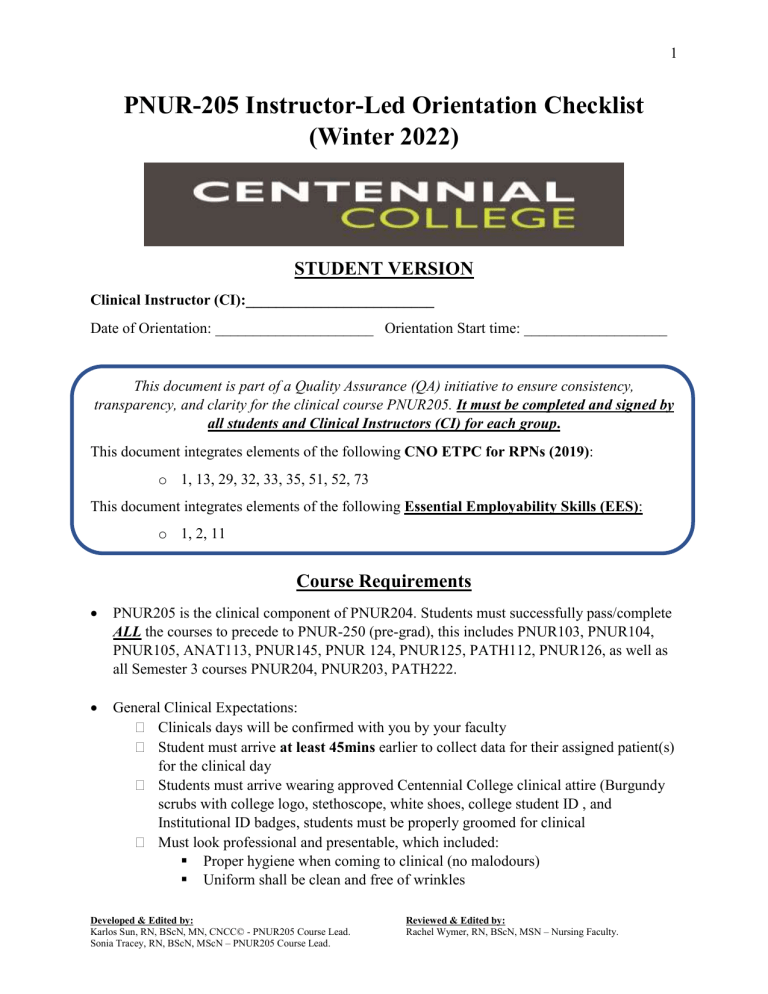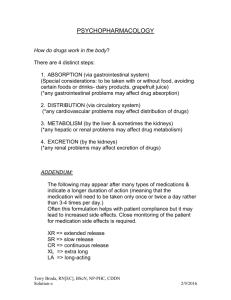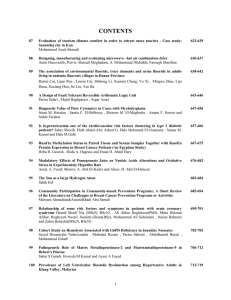
1 PNUR-205 Instructor-Led Orientation Checklist (Winter 2022) STUDENT VERSION Clinical Instructor (CI):_________________________ Date of Orientation: _____________________ Orientation Start time: ___________________ This document is part of a Quality Assurance (QA) initiative to ensure consistency, transparency, and clarity for the clinical course PNUR205. It must be completed and signed by all students and Clinical Instructors (CI) for each group. This document integrates elements of the following CNO ETPC for RPNs (2019): o 1, 13, 29, 32, 33, 35, 51, 52, 73 This document integrates elements of the following Essential Employability Skills (EES): o 1, 2, 11 Course Requirements PNUR205 is the clinical component of PNUR204. Students must successfully pass/complete ALL the courses to precede to PNUR-250 (pre-grad), this includes PNUR103, PNUR104, PNUR105, ANAT113, PNUR145, PNUR 124, PNUR125, PATH112, PNUR126, as well as all Semester 3 courses PNUR204, PNUR203, PATH222. General Clinical Expectations: Clinicals days will be confirmed with you by your faculty Student must arrive at least 45mins earlier to collect data for their assigned patient(s) for the clinical day Students must arrive wearing approved Centennial College clinical attire (Burgundy scrubs with college logo, stethoscope, white shoes, college student ID , and Institutional ID badges, students must be properly groomed for clinical Must look professional and presentable, which included: Proper hygiene when coming to clinical (no malodours) Uniform shall be clean and free of wrinkles Developed & Edited by: Karlos Sun, RN, BScN, MN, CNCC© - PNUR205 Course Lead. Sonia Tracey, RN, BScN, MScN – PNUR205 Course Lead. Reviewed & Edited by: Rachel Wymer, RN, BScN, MSN – Nursing Faculty. 2 Students with long hair (Ladies or Gentlemen) must tie hair up and hair should NOT touch shoulder. Hair must not be loose, no Pony tails. Eating or drinking is PROHIBITED in clinical areas. You may use the cafeteria or staff lounge. There will be no eating or drinking during clinical times. You may do so during your breaks. You may have a sip of water in a private spot and return to your duties immediately. Competence donning and doffing of PPE. This was learned in PNUR105 and students must be able to demonstrate competence (Review this skill) Labs are mandatory at the College during weeks 4, 7 & 11. Your instructors will provide you with the specific date, time, and location in advance via email. Additionally, a SimLab will be scheduled later in the semester. Date TBA. Students must provide their instructor with a copy of their mask fit card for their N95 mask. Student will show respectful language, demeanor, actions and behavior AT ALL TIMES during clinical towards the patients, family members, hospital staff and the instructor/faculty. Respect and uphold patient confidentiality at all times. Students are required to review their PNUR103 content and the CNO Confidentiality and Privacy document as well as the Code of Conduct to ensure there are meeting the requirements of the CNO. Students must also review the Institutional requirements for their clinical placement. This means: DO NOT share patient’s data outside of the circle of care. DO NOT take picture with your phone of the patient’s chart or computer screens. All information must be written down for your assignments only. DO NOT discard patient’s information in the garbage or regular recycling. Dispose of patient’s confidential information (your assignments, in confidential bins at the end of clinical ONLY) DO NOT talk about your patient in public places (outside of clinical, in elevators, cafeteria, washrooms, etc.) DO NOT post patient information on social media (Facebook, Instagram, TikTok, Tweeter, YouTube, etc.) DO NOT text your family or friends information about your patient, their condition, or the care they are receiving. DO NOT make copies of the chart, or print chart content from the computer to take home. This is content learned in PNUR103. ALL students should be very familiar with these concepts and components. Violation of ANY of the above confidentiality rules will warrant **IMMEDIATE TERMINATION OF CLINICAL PLACEMENT FOR THE REMAINING OF THE SEMESTER, with an AUTOMATIC FAIL grade and REMOVAL FROM CLINICAL INSTITUTION and BLOCKED FROM FUTURE CLINICALS AT THAT INSTITUTION.** Developed & Edited by: Karlos Sun, RN, BScN, MN, CNCC© - PNUR205 Course Lead. Sonia Tracey, RN, BScN, MScN – PNUR205 Course Lead. Reviewed & Edited by: Rachel Wymer, RN, BScN, MSN – Nursing Faculty. 3 If you are not feeling well, you must inform your Clinical Instructor (CI) at least 4 hours prior to clinical shift start. In case of an emergency, you must email CI as soon as you are able to, and inform CI of your absence in clinical. Students who are absent from clinical must complete the Student Absenteeism Reporting Form. This Form is on eCentennial and must be completed for ANY absenteeism reasons. Cellphone usage: You may not use your phones in open clinical areas (that means where staff, patients, or faculty can see you). You may keep your phone on for emergencies. If you need to answer a call, you must step into a private area to do so. As there are plenty of computers in the unit, you must use the computers to look up clinical information, NOT your phones. Medication administration under any route (oral, subcutaneous, intramuscular, inhalation, nebulization, intravenous, transdermal, etc.) will always be performed under your CI’s supervision. Students can proceed to administer medications with CI ONLY after proving to CI with the knowledge, skill, judgement, application, and SAFETY of the drug. If students do not have the knowledge, skills or judgement to administer the drug, THEY WILL NOT DO SO. (Review CNO Practice Standard Medication prior to clinical) Failure to safely administer medications will be noted on students’ weekly evaluations. Documentation must be completed in a timely, accurate, orderly, completely, and frequent manner. This means: Timely: Charting as soon as possible after care or interventions have been provided. Accurate: Charting normal & abnormal findings objectively. Abnormalities must be documented thoroughly AFTER informing & reviewing with clinical instructor. Orderly: Charting must be done systematically and orderly. Charting correctly under the appropriate sections designated for that documentation. Frequently: Charting after each assessment, intervention or evaluation of patients’ conditions or changes. Document no matter how big or small. Your CI will review all your charting before dismissing you for post-conference. If you charting is incomplete or inaccurate, the CI and student must spend time together to correct it, even if this means staying after clinical. For all narrative documentation, CI must approve the documentation before putting them in charts or filing electronically. Developed & Edited by: Karlos Sun, RN, BScN, MN, CNCC© - PNUR205 Course Lead. Sonia Tracey, RN, BScN, MScN – PNUR205 Course Lead. Reviewed & Edited by: Rachel Wymer, RN, BScN, MSN – Nursing Faculty. 4 Abnormal Clinical findings MUST be reported ASAP to CI. This includes, but not limited to: Abnormal vital signs Abnormal findings from head-to-toe assessment Safety issues (fall risk, agitation, medical emergencies, etc.) Medication errors or near misses Must be honest with CI regarding skill competence. If you have not performed the skill, do not say that you have. This demonstrates accountability and transparency. You will receive frequent and immediate feedback every clinical shift you’re your CI (unofficially) along with a formal weekly clinical feedback (official) through eCentennial. Students are NOT allowed to take any gifts (monetary or presents) from patients or their families. In such a case, student must inform instructor and instructor will provide guidance. On your course shell there is an Important due dates document. Ensure you download and review this document. Your CI will advise you of any changes, otherwise the due dates and expectations in the Important dates document must be followed to be successful in this course. Labs You are required to be prepared for all scheduled labs at the College. Please review the content on eCentennial and complete the pre-lab readings and work prior to attending labs and Sim lab. Completion of prep work for lab is an expectation. Failure to adequately prepare will result in suboptimal learning for students and inability to demonstrate safety to continue in the lab. This will be reflected on your evaluations. There are 3 scheduled 7 hour labs this semester that you are required to attend. The course shell, and the Success Road map (found with the Course Outline) highlight all the details for each lab including preparatory readings. Please take time to review this information. Week 4 Lab: Schedule will be posted with your specific date and room # on eCentennial. o o IV Therapy (from initiation to discontinuation) Pre and Postoperative Care Week 7 Lab: Schedule will be posted with your specific date and room # on eCentennial. o o Part 1: Blood Transfusion Lab Part 2: Return Demonstration: IV Therapy (Individual student assessment) Developed & Edited by: Karlos Sun, RN, BScN, MN, CNCC© - PNUR205 Course Lead. Sonia Tracey, RN, BScN, MScN – PNUR205 Course Lead. Reviewed & Edited by: Rachel Wymer, RN, BScN, MSN – Nursing Faculty. 5 Week 11 Lab Schedule will be posted with your specific date and room # on eCentennial. o o o o Antepartum Intrapartum Postpartum Care of the Newborn Math Tests: You are required to complete 2 math tests this semester and reach a certain competency prior to moving forward. All tests will be proctored using online proctoring software. The proctoring videos will be reviewed for any signs of Academic Dishonesty. The course shell will highlight which software will be used for this course. Please ensure you review and become familiar with the requirements. Failure to follow the requirements or incidences of Academic Dishonesty will be subject to the College Academic Honesty and Plagiarism policy. What to expect on your first clinical day (A sample day) Activities on Orientation day 1 (This is a sample your CI may offer other activities) Arrive at your institution time: ____________________________________ Review of clinical expectations: ___________________________________ Unit tour time: _________________________________________________ Review of clinical skills time: _____________________________________ Performing Vital signs (learned in PNUR105) Interpreting vital signs (learned in PNUR104 and 105) Performing head-to-toe assessment (learned in PNUR126) Donning and Doffing of PPE (learned in PNUR105) Putting on and removing sterile gloves (learned in PNUR125) Demonstrate wound care/dressing change* (learned in PNUR124 and 125) Review of anatomy relevant to your unit (learned in ANAT113) Review of interviewing /Therapeutic Communication (learned in PNUR103) Your instructor will also provide you with the best way to reach them. Developed & Edited by: Karlos Sun, RN, BScN, MN, CNCC© - PNUR205 Course Lead. Sonia Tracey, RN, BScN, MScN – PNUR205 Course Lead. Reviewed & Edited by: Rachel Wymer, RN, BScN, MSN – Nursing Faculty. 6 Declaration of Understanding & Clinical Agreement (Upload this signed paged to eCentennial under Assessments > Assignment > Signed Declaration of Understanding & Clinical Agreement Folder) I have reviewed and completed the orientation provided by my Clinical Instructor (CI), which included a review of all of the above items with my CI / Faculty on (date)____________________________. I was given the opportunity to ask questions and had my questions answered by my CI to the best of their abilities. I also have access to the course outline and detailed course shell for further information and guidance if needed. Student name :____________________________________________________ Student number: __________________________________________________ Student Signature:_________________________________________________ Date: ___________________________________________________________ Faculty Co-Signature: ______________________________________________ Developed & Edited by: Karlos Sun, RN, BScN, MN, CNCC© - PNUR205 Course Lead. Sonia Tracey, RN, BScN, MScN – PNUR205 Course Lead. Reviewed & Edited by: Rachel Wymer, RN, BScN, MSN – Nursing Faculty.



